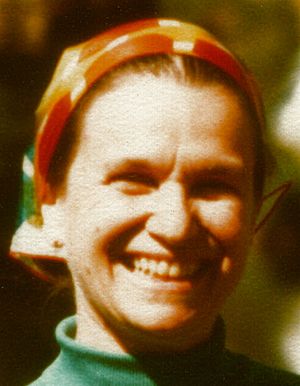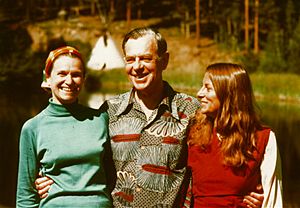Jean Erdman facts for kids
Quick facts for kids
Jean Erdman
|
|
|---|---|

Erdman in the late 1970s
|
|
| Born | February 20, 1916 Honolulu, Hawaii, U.S.
|
| Died | May 4, 2020 (aged 104) Honolulu, Hawaii, U.S.
|
| Nationality | American |
| Occupation |
|
| Spouse(s) | |
| Awards | Vernon Rice Outstanding Achievement in Theatre 1963 The Coach with the Six Insides, Outstanding Choreography 1972 The Two Gentlemen of Verona |
Jean Erdman (born February 20, 1916 – died May 4, 2020) was an American dancer and choreographer. She was also a director for avant-garde theater. She helped shape modern dance and theater in new and exciting ways.
Contents
Biography
Early Life and Dance Beginnings
Jean Erdman was born in Honolulu, Hawaii. Her father, John Piney Erdman, was a minister. Her mother, Marion Dillingham Erdman, came from a well-known Hawaiian family.
Jean's first dance experiences were with the hula. She also learned Isadora Duncan interpretive dance at the Punahou School. These early lessons taught her that dance is about expressing meaning. It's not just about doing lively steps.
She later went to Sarah Lawrence College. There, she explored her interests in theater, dance, and philosophy.
Important Teachers and Influences
At Sarah Lawrence, Jean met two people who greatly influenced her. One was Joseph Campbell, a professor who later became famous for studying myths. They talked a lot about art and personal growth.
Her other big influence was Martha Graham. Jean learned modern dance from Graham. She also attended summer dance schools.
In 1937, Jean traveled the world with her family. She saw traditional dances and theater in places like Bali, Java, and India. This trip taught her that each culture's dance perfectly shows its view of the world.
Soon after returning, Jean married Joseph Campbell in 1938. She then joined the Martha Graham Dance Company.
Dancing with Martha Graham
Jean became a main dancer in Martha Graham's company. She performed important solo roles. For example, she was the Speaking Fate in Punch and the Judy. She also played the One Who Speaks in Letter to the World. Critics praised her performances.
Jean helped change the role of the One Who Speaks. She made it a moving part of the show. This experience made her interested in how words and movement work together.
Becoming a Choreographer
Jean also studied choreography with Louis Horst, Graham's music director. Her first solo dance was The Transformations of Medusa. It premiered in 1942. This dance stayed in her performances for many years.
The Transformations of Medusa explored ancient dance styles. Jean learned that every dance pose can show a "whole state of being." Joseph Campbell helped her connect the dance to the Greek myth of Medusa.
Collaborations and New Ideas
In 1943, Jean Erdman and fellow dancer Merce Cunningham performed together. They worked with composer John Cage. Their duets included "Credo in US" and "Ad Lib." "Ad Lib" was special because it used improvisation. This was quite new for public performances back then.
Jean created many other important dances in the 1940s and 1950s. These included Daughters of the Lonesome Isle (1945) and Ophelia (1946). She often worked with composers like John Cage and Lou Harrison. Her work was known for being unique and expressive.
Dance critics noticed her special way of creating dances. They said her movements were very creative. They also said her dances were like "poetic presence."
From 1950 to 1954, Jean toured the U.S. with her dance company. In 1954-1955, she toured India and Japan as a solo artist. She was the first dancer to do this after World War II. Her report helped start cultural exchange programs with these countries.
Jean Erdman Theater of Dance
In 1960, Jean renamed her company the Jean Erdman Theater of Dance. She wanted to explore how movement, music, art, and words connect. She had been interested in this for a long time.
She choreographed plays like The Flies (1947) and The Enchanted (1950). She also directed and choreographed Otherman or The Beginning of a New Nation (1954).
Her company toured the U.S. and performed in New York City. Notable works included Twenty Poems (1960). This dance used poems by E. E. Cummings and music by Teiji Ito.
The Coach with the Six Insides
In 1962, Jean began her most famous work, The Coach with the Six Insides. This was a dance and theater show based on James Joyce's book, Finnegans Wake. The title comes from a line in the book.
The show focused on the main female character, Anna Livia Plurabelle. Jean danced all parts of Anna Livia, from young to old. Teiji Ito created the music using instruments from all over the world.
The Coach with the Six Insides opened in New York City in 1962. It ran for 114 shows. It won the Obie Award and the Vernon Rice Award for Outstanding Achievement in theater. The show then toured the world, including Paris and Tokyo. Many people still see it as a great example of combining dance and words.
Jean also choreographed other theater shows. These included Hamlet (1964) and Yerma (1962). She also choreographed the rock-opera Two Gentlemen of Verona (1971–72) on Broadway. For this, she won a Drama Desk Award.
Teaching and Legacy
Jean Erdman was also a dedicated teacher. In 1948, she opened her own studio. She taught a unique dance technique. It combined world dance styles with how the body works. She wanted to help students become skilled dancers.
She directed the modern dance department at Columbia University. She also led the dance department at the University of Colorado. From 1966 to 1971, she was the founding director of the dance program at NYU's Tisch School of the Arts.
In the 1980s, Jean started performing her older dances again. This led to the Jean Erdman Retrospective in 1985. A critic said that anyone wanting to understand modern dance could find its roots in her work. She also helped create a video archive of her early dances called Dance and Myth: The World of Jean Erdman.
Personal Life
Jean Erdman and Joseph Campbell were married for 49 years. They did not have children. They lived in a small apartment in Greenwich Village, New York. Later, they also had an apartment in Honolulu.
Joseph Campbell passed away in 1987. In 1990, Jean became the first president of the Joseph Campbell Foundation. She continued to be involved with the foundation until her death. From 1995, she lived only in Hawaii.
Jean Erdman died on May 4, 2020, in Honolulu. She was 104 years old.
Filmography
- Invocation: Maya Deren (1987)
- The Hero's Journey: The World of Joseph Campbell (1987)
- Dance and Myth - The World of Jean Erdman (1990)
Awards and Nominations
- Awards
- 1972: Drama Desk Award for Outstanding Choreography - The Two Gentlemen of Verona
- 1963: Obie Award - Special Citation - The Coach with the Six Insides
- 1963: Vernon Rice Award for Outstanding Achievement in Theatre - The Coach with the Six Insides
- 1993: Heritage Award from the National Dance Association for contributions to dance education
- 1995: Sacred Dance Guild Honorary Lifetime Member
- Nominations
- 1972: Tony Award for Best Choreography - The Two Gentlemen of Verona
See also
 In Spanish: Jean Erdman para niños
In Spanish: Jean Erdman para niños


